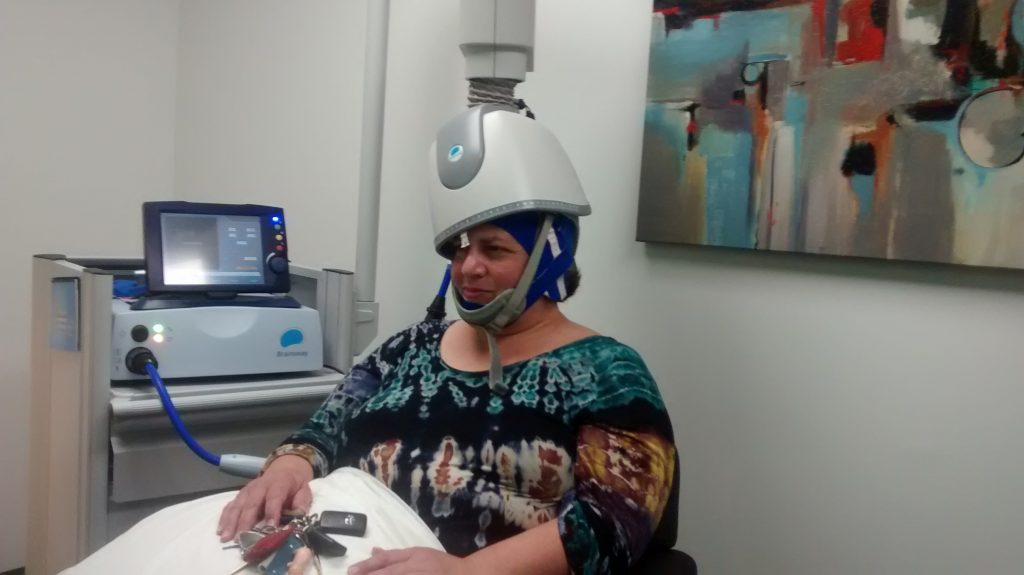Armené Margosian, 52, of Greenfield, sat waiting in a medical chair at Achieve TMS East’s Northampton office on Pleasant Street, her hands holding a pillow alongside her car keys. Her head was covered in a dark blue cap, while strapped into a metal, robotic-looking helmet. A magnetic pulse the machine delivered 36 times over the span of two seconds caused her right eye to twitch, but didn’t cause her any pain.
Margosian is treating her clinically diagnosed severe depression with a new methold — transcranial magnetic stimulation (TMS). Years of taking pills and talking weren’t working so, she underwent TMS treatment from April to June for five days a week during a six-week period. TMS helped her regain a sense of normalcy in her life, having previously been hospitalized for her depression.
She said she had been considering electroconvulsive therapy, a procedure done under general anesthesia that involves small electric currents passing through the brain that can sometimes result in changing the brain’s chemistry.
“I pursued every avenue possible. I attended groups and individual therapy. I tried to sign up for workshops just to help myself. But I just couldn’t shake the feeling,” she says.
Margosian said she’s dealt with depression for most of her life.
“I grew up in an abusive family; lots of violence,” she says. “There was just multiple traumas and so I think where it became most notable was during my teenage years and my family wouldn’t seek any help for it. So, I suffered alone.”
Margosian said she sleeps better and had more energy after undergoing TMS treatment .
“I really didn’t realize how poorly I had been sleeping for years,” she says.
The U.S. Food and Drug Administration approved TMS for treating depression in 2008, according to the department’s website.
Dr. Brian Smith, a neurologist for over 20 years who is the principal at TMS East, says patients who have major depressive disorder and have tried to treat their depression through pharmaceutical drugs to no avail are only considered for the treatment due to medical guidelines. Major depressive disorder is defined as having at least two weeks of low mood that is present across most situations. Side effects of this treatment have included mild headaches and on rare occurrences there have been seizures.
Smith says TMS works by using a magnetic coil placed on the patient’s head to deliver a magnetic pulse to a specific area of the brain. The magnetic pulse causes nerve cells in the brain to release neurotransmitters, which stimulate areas in the brain that are not functioning optimally in people with depression. The brain’s chemistry changes similarly to what would be found with other treatment methods such as medications and electroconvulsive therapy.
John Donlan, a technician at Achieve TMS, administers 36 pulses over the span of two seconds to Margosian. He said a normal session lasts about 20 minutes in which the pulses are repeated 55 times with 20 second breaks in between.
“It’s uncomfortable at the very beginning, but it’s done gradually so I was acclimated into it,” Margosian said. “Once it’s done, it’s kind of weird, you just want it to keep going.”
I don’t have depression, but I was able to experience TMS treatment firsthand on the lowest setting, a single pulse. I was a little anxious sitting in the medical chair, not knowing what to expect.
Donlan placed the helmet over my head. It wasn’t that bizarre. It felt like a normal sports helmet. He counted down from five, telling me to relax my hands on the pillow and that my hand might twitch as an involuntary reaction from the treatment. As soon as the countdown ended, a pulse was fired that felt like a woodpecker gently knocking on my skull to say, “Hello.” It wasn’t painful; but was definitely a foreign sensation. A couple seconds later I could feel echoes of the vibration near my temple, but half a minute later that feeling disappeared.
Smith thinks that as TMS becomes more well-known and accepted, it could potentially be a treatment that’s used before medication.
“This is not a new treatment. Stimulating the brain has been around for a 100 years. This treatment has been around since 1985. There’s over 10,000 [scientific] articles on this treatment,” Smith says.
TMS is being looked at as a treatment for post traumatic stress disorder, obsessive compulsive disorder, and neurological disorders like autism and Parkinson’s disease, he says.
Lori Astheimer, a lecturer with the department of psychological and brain Sciences at the University of Massachusetts Amherst with a background in neuroscience, says she thinks more research is needed in regards to TMS, but believes the results for treating depression and other disorders have been promising.
“Using it to treat depression, I think, can be effective for a lot of patients,” she said. “There’s good evidence for that. Like pharmaceutical interventions, the interventions don’t work for everyone.”
Astheimer says although a lot of research has been accomplished thus far in regards to TMS, more information is needed about why TMS works for some people and not others, and how the treatment could be used for other disorders.
Margosian said shes going to stick with the treatment because falling into a depressive spell is far more painful.
“There’s such a fear of going back into that [depression] because it feels like a bottomless pit,” she says.
“You’re in free fall and you don’t know what to do to save yourself. Even though there’s supposed help out there, there really isn’t. And a lot of the medications have a lot of side effects that are really detrimental … The depression just ran me down and then you just start giving up. I think that this [treatment] was just really hopeful. It gave me more hope just knowing that there was something there to help me.”
Chris Goudreau can be reached at cgoudreau@valleyadvocate.com.



